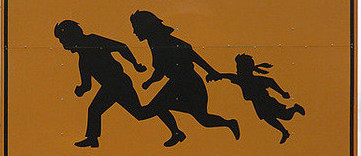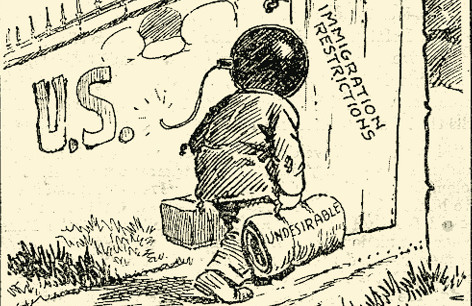





Framing Immigration: Geo-Ethnic Context in California Newspapers
In 2006, millions of immigrants protested in cities around the nation against H.R. 4437, a new bill in Congress that threatened to treat undocumented immigrants as felons. A content analysis of news coverage of the bill revealed that frames of the restrictionist immigration legislation varied based on race and geography of the surrounding community. These results suggest that geo-ethnic context, which has been studied in terms of communication infrastructure within communities, should be taken into account when trying to understand how an issue is framed, particularly when trying to explain and predict why and when certain frames might occur.

Race and Body Image on Queerty.com
In this study, we conducted a content analysis of 214 images of male models published on the gay-oriented blog Queerty.com from May, 2007 to March, 2010. Results showed that most models were White, in their twenties, and had low levels of body hair. Almost uniformly, models had low levels of body fat and high levels of muscularity. Additionally, models’ body types varied significantly by race. Implications of these findings are discussed.
The Effect of Geography on Attitudes Toward Latinos
The Effect of Geography on Group Threat Theory and Attitudes toward Latin American Immigrants
This secondary analysis examined group threat theory by looking at the relationship between the perceived number of immigrants in a particular area and the prejudicial attitudes toward Latin American immigrants. Traditionally, group threat theory has been shown to have an effect on attitudes toward Blacks but not toward Latinos. Findings from this study indicate that estimating high numbers of immigrants is not a reliable predictor of strong prejudicial attitudes toward Latin American immigrants. However, predictions of higher numbers of immigrants do appear to vary significantly by geography, suggesting that Latinos are impacted by group threat theory but have been overlooked because of a national sample that was suppressing the relationship.

Testing Group Threat Theory and the Contact Hypothesis on Asian Immigrants
This secondary analysis examined attitudes toward immigrants by looking at group threat theory, which tests the relationship between the perceived number of immigrants in a particular area and the prejudicial attitudes toward Asian immigrants. We also examined the contact hypothesis, which suggests that the more interaction between groups the lower the levels of prejudice, as it relates to Asian immigrants. Traditionally, group threat theory has been shown to have an effect on attitudes toward Blacks but not toward Latinos or Asians.
Findings from this study support the contact hypothesis as it applies to Asian immigrants. Findings of this study also confirm that larger estimates of immigrants do not predict strong prejudicial attitudes toward Asian immigrants, suggesting that Asian immigrants occupy a unique position that challenges the racial ordering hierarchy.
Co-author: Yeon Kyeong Kim, University of Iowa
Patrolling Whiteness: Framing the Minuteman Project on the Evening News
This study explores how Whiteness was framed in network television news coverage of the Minutemen, a group of volunteers who stationed themselves along the U.S.-Mexico border to prevent immigrants from illegally entering the country. In a visual-textual analysis, I examined stories about the group that aired on the evening news broadcasts. I found that, through a series of frames enacted by the Minutemen and reinforced by the news stories, Whiteness remained invisible while the threat toward Whiteness became pronounced. The Minutemen embraced Whiteness and literally policed its border, controlling the dialogue, and historically editing what did not fit with the established hegemonic narrative.
Source Influences on Framing the Intelligent Design Debate
“Teach the controversy:” The relationship between sources and frames in reporting the intelligent design debate
This study examined sources and frames in the debate over whether to teach evolution or intelligent design in public schools. A content analysis of 12 newspapers from Kansas, Ohio, and Pennsylvania was conducted to see how geography and sourcing affected the framing of the controversial science issue. Established patterns of reporting science were repeated in the news coverage, but location and sources played an important role in how the issue was framed. The frames varied by region, suggesting a new direction for future research of framing.
Protesting Immigration: Attitude Congruency and the Behavioral Component of the Third-Person Perspective
This study examined the relationship between attitude congruency and third-person perceptions of influence of news media.
Two experiments were conducted to determine the effects of this relationship on willingness to support protests, using immigration as a topic.
Findings indicate that attitude-congruent news stories have strong perceived influence on individuals, but not on others. Individuals were supportive of attitude-congruent protests, but TPP and the news stories were unrelated to protest support.
Traditional operationalization of the behavioral component is questioned.
Co-author: Dr. Julie Andsager, University of Iowa
Testing Group Threat Theory on Asian and Latino Immigrants
This secondary analysis examined group threat theory by looking at the relationship between the perceived number of immigrants in a particular area and the prejudicial attitudes toward Latin American immigrants. Traditionally, group threat theory has been shown to have an effect on attitudes toward Blacks but not toward Latino/as. Findings from this study indicate that estimating high numbers of immigrants is not a reliable predictor of strong prejudicial attitudes toward Latin American immigrants. However, predictions of higher numbers of immigrants do appear to vary significantly by geography, suggesting that Latino/as are impacted by group threat theory but have been overlooked due to national sampling suppressing the relationship.
Mirror, Mirror: Hegemonic Framing of Malcolm X and Martin Luther King, Jr. in the New York Times
This study explores how Malcolm X and Martin Luther King, Jr., were framed by the New York Times from 1960 through 1965.
Drawing on concepts of hegemony and racism, a textual analysis was used to examine 136 articles mentioning King and 44 articles mentioning Malcolm X.
Coverage of each man was compared with the other for evidence of framing.
The study found four recurring themes surrounding the coverage of these two men: the diminishment of Malcolm X as a leader, a mistrust and skepticism of Malcolm X and the Black Muslims, a deep fear of racial violence, and the stigmatization of Malcolm X.
Through this framing, Malcolm X was labeled as a deviant while Martin Luther King, Jr., was embraced as a righteous leader. These characterizations reinforced hegemonic power structures while also supporting ideological notions of accepted racial norms in the United States.
Happily Ever After: Myth, Rape, and Romance in the Mary K. Letourneau Case
Mary Kay Letourneau, a teacher who raped her 12-year-old student. We examined magazine coverage surrounding the event to determine what narratives were used to explain a crime that reversed the traditional roles of criminal and victim. We found that journalists relied on rape misconceptions and myths of proper (hetero)sexual roles, including the Good Mother and Princess in romantic fairy tales to tell the story.
The construction of this narrative erased the crime, turning rape into romance and (re)establishing masculine hegemony.
Co-author: Dr. Dustin Harp, University of Texas at Austin
Framing Private Lynch: Establishment and tenacity of the hero frame during war
Following the rescue of Jessica Lynch, a soldier captured during the invasion of Iraq, media outlets incorrectly sensationalized events surrounding her capture, imprisonment, and rescue.
Using Lule’s components of a hero, newspaper articles and news transcripts were analyzed for these attributes, and a Web forum was studied to gauge reaction.
A hero frame was present in the press and, for at least a portion of the population, the frame was a stubborn one.